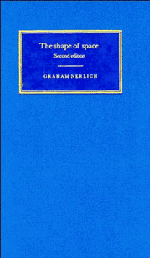Book contents
- Frontmatter
- Contents
- Preface
- Introduction
- 1 Space and spatial relations
- 2 Hands, knees and absolute space
- 3 Euclidean and other shapes
- 4 Geometrical structures in space and spacetime
- 5 Shapes and the imagination
- 6 The aims of conventionalism
- 7 Against conventionalism
- 8 Reichenbach's treatment of topology
- 9 Measuring space: fact or convention?
- 10 The relativity of motion
- Bibliography
- Index
- Frontmatter
- Contents
- Preface
- Introduction
- 1 Space and spatial relations
- 2 Hands, knees and absolute space
- 3 Euclidean and other shapes
- 4 Geometrical structures in space and spacetime
- 5 Shapes and the imagination
- 6 The aims of conventionalism
- 7 Against conventionalism
- 8 Reichenbach's treatment of topology
- 9 Measuring space: fact or convention?
- 10 The relativity of motion
- Bibliography
- Index
Summary
Space poses a central, intriguing and challenging question for metaphysics. It has puzzled us ever since Parmenides and Zeno argued paradoxically that spatial division and therefore motion were impossible and Plato wrote of space in Timaeus as an active entity in the working of the world. It is easy to see why space is so problematic. On the one hand, we are drawn to make very powerful statements about it. Everything that is real has some spatial position. Space is infinitely large, infinitely penetrable and infinitely divisible. On the other, despite our confidence in these strong claims, space seems elusive to the point of eeriness. It seems to be largely without properties, apart from the few strong ones just recited. It is imperceptible by any mode of perception. It has no material property, no causal one, it does nothing. It seems to have no feature which we can learn about by observation. Arguably, it has a prominent role in natural science but it is far from obvious just what it is. Though being spatial is a mark of the real, space itself seems, paradoxically perhaps, unreal a mere nothing.
This outlines some of the nodal points of an ancient debate in a rather artless way. If any of the strong claims is correct we can find out which only after carefully arguing through a range of intricate issues. A great light has been shed on the whole issue by developments in geometry and the sciences, especially in this century and the last.
- Type
- Chapter
- Information
- The Shape of Space , pp. 1 - 10Publisher: Cambridge University PressPrint publication year: 1994



